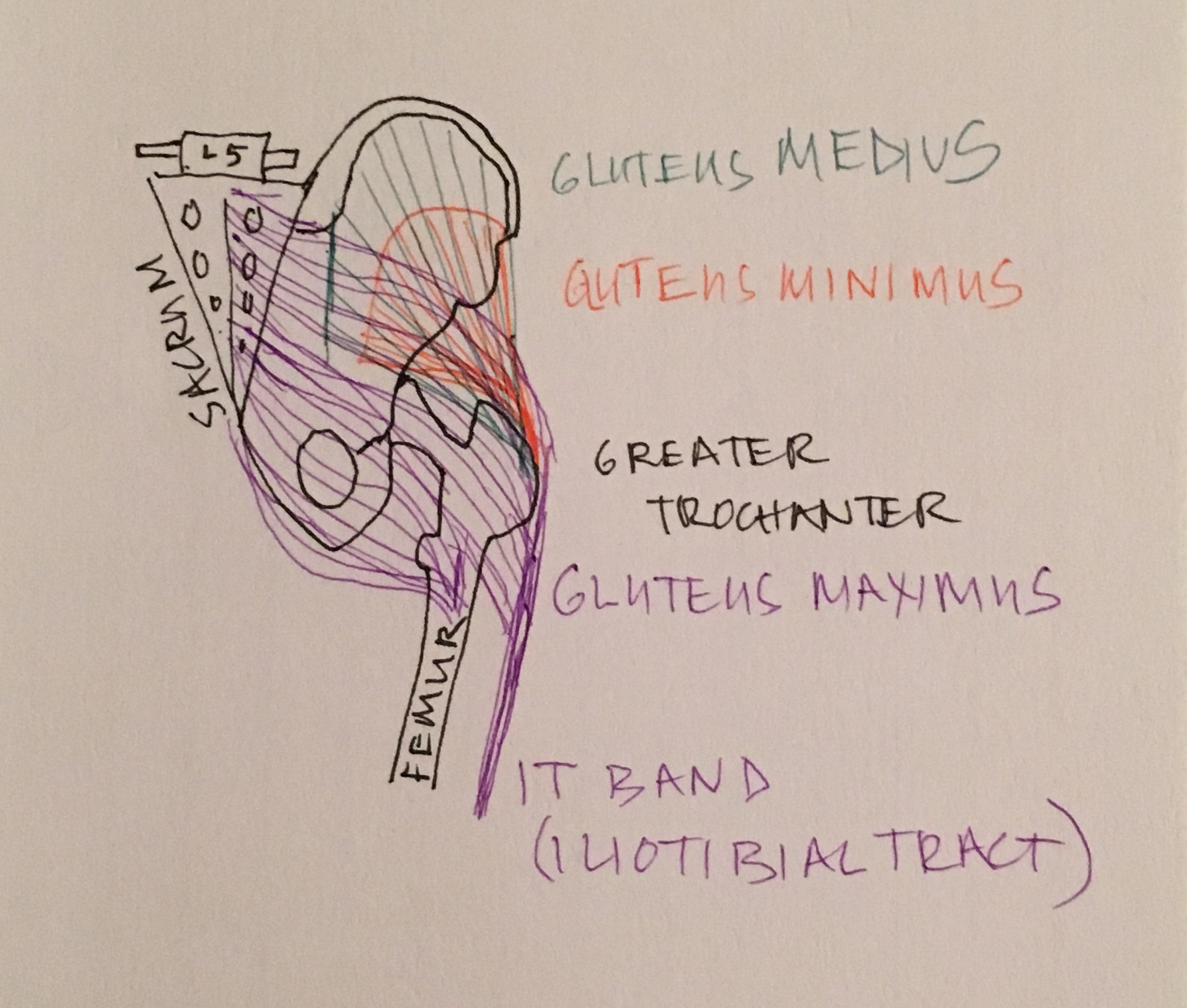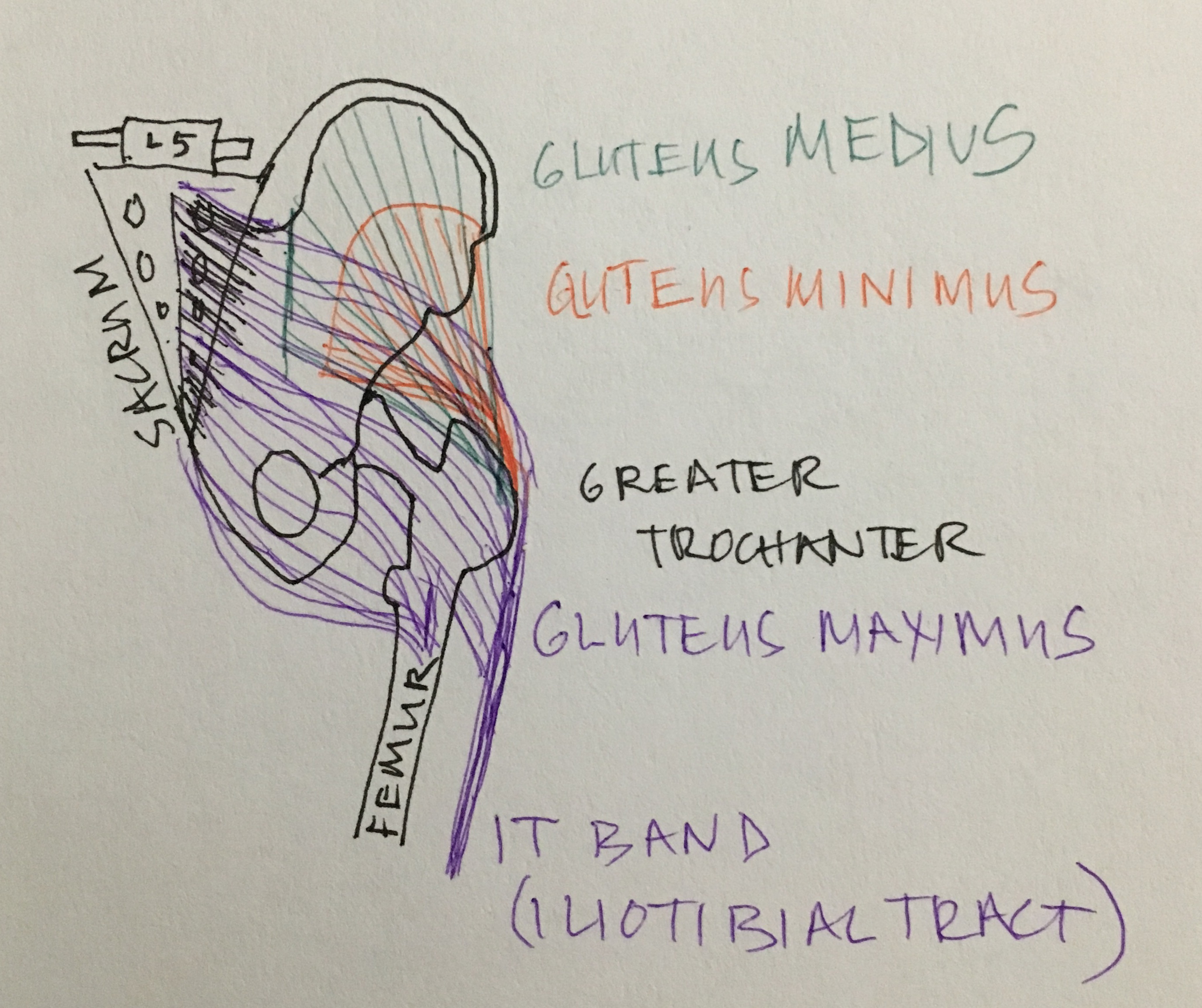Yep. Are you like Troy Barnes? Do you love Butt Stuff? Well then you’re in luck! We covered Butt Stuff this week. And by “Butt Stuff” I mean all that meat that covers your backside. Did you know that there are actually 3 different gluteal muscles that make up “the glutes”? Yes! It’s true.
The gluteus maximus is the big boy, as the name implies. It runs from the lateral edge of your sacrum all the way out to your femur (the long bone in the top of your leg). The top part of the muscle merges into the IT band on the outside of the leg, and the lower portion attaches to the back of your femur. But underneath that are two more glute muscles! The gluteus medius lies underneath the maximus, and underneath THAT lies yet another muscle – the gluteus minimus. Please see my quick sketch below to get an idea of how these muscles lie in relation to each other. And yes, I forgot the “l” in gluteus minimus and had to go back in and squeeze it in later. Thank you, Tim, for the .388mm pens. 🙂
Underneath all of these layers are the deep rotators of the hip, but I’ll have to save those for another blog post, or this will get too massively long, and I have a test to study for! And a bike ride and brunch to do!
So, your glutes. Why are they important? Well, glute max is the largest muscle in the body and can be up to 2 to 3 inches thick! Consequently, it can have a huge impact on postural distortions. The glute group can cause pelvic extension (a “tucked” tail), pelvic projection (where the hips are thrust forward of the feet and knees), a pelvic tilt (where one side of the pelvis is higher than the other), external rotation of the femur (“duck feet”), and low back pain. These muscles can also mimic sciatic pain – sending trigger point referrals into the buttocks and down the back and side of the leg.
Issues with the glutes are quite common, considering we are supposed to use them to MOVE all day long, but we generally just use them to SIT all day long instead. As a result, many people have difficulties activating their “sleepy” glutes. This became really evident to me when I took a Yoga Tune Up® workshop where we went through the following guided practice:
- Lay on the floor, legs straight out (aka savasana).
- Try to squeeze your right butt check. Try the left. Do you know notice any difference in power/contraction? How far did your hips lift off the floor with each squeeze?
- Take a massage therapy ball (a Yoga Tune Up ball, a tennis ball, etc.) and place it under the thickest part of just the right butt cheek.
- Contract the right butt cheek for 20 seconds, as you release the contraction, the ball will sink deeper into the glutes. Repeat 2-3 times, sinking deeper each time.
- You can rock your body slowly side to side over the ball.
- Without sitting up, reach under your glute and remove the ball.
- Let your awareness settle back into the glutes. Does the right side feel any different than the left? Any changes in temperature? sensation?
- Contract the right butt cheek. Then the left.
- Do you notice any difference in power/activation/sensation in the right side?
If you were like me, you were like, “OMG. My right side has so much more power now!!!” You just woke up your butt!!
The YTU balls are great for increasing proprioception and awareness of these muscles, and with regular use, you can keep these muscles active and reduce the chronic tension that is held there. At the Center for Neurosomatic Studies, we are trained to treat this group of muscles VERY specifically. In addition to treating the muscle belly (which is what you contact with the balls), we get into the attachments and different layers of tissue, and we can even get into that trough on the medial aspect of the greater trochanter. The combination of self-massage and bodywork is super helpful for this powerhouse.
Let me know if you have any questions or comments. If you try the exercise described above, let me know how it feels for you. I personally store a lot of tension in my glutes, so when I get them treated or I roll them out, I feel super relaxed and down-regulated afterwards. Good luck waking up your butt!


